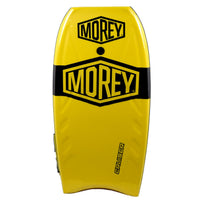
Morey Cruiser 42.5" Bodyboard
Morey
THE BASICS Want to get into bodyboarding on a budget? The Morey Cruiser was made for you. → LARGER RIDER? Check out the Morey Big Kahuna. → WANT ...
View full detailsThe Mach 7 is widely known as one of the most popular boards available, and it's clear why. It has stood the test of time, through several iterations, all spanning from the initial invention: the boogie board.
But the Mach 7 wouldn't exist if it wasn't for one surfer and engineer, Tom Morey. Morey Boogie started back in the 1970s, starting with the Boogie Board in 1971.

Nowadays, you'll find a bunch of Mach 7 models, ranging from the current-model Mach 7 all the way to the Mach 7SS.
Let's first dive into the Mach 7, compare it to some cheaper Morey boards, then take a look at the features and history of the board.
The Mach 7 was actually my second board (I started out on a lower-priced Morey Cruiser). The difference between the two boards is pretty massive, actually. This is mainly due to the difference in core - the Mach 7, utilizing a PE core, comes out weighing a whole lot more than the EPS in the Cruiser.
Quick Note: A PE core works great in cold waters. It's also decent in warmer waters, but it is heavier and denser than an EPS core. You can learn more about the different bodyboard core types here.
Feature-wise in the Mach 7, you're adding a bunch of things that you didn't know you were missing out on with a Cruiser, notably the upgraded TC8 deck and a Power Rod Stringer, two things that keep this board moving through rough surf.
As noted above, with a Mach 7 you get a PE core, which feels and rides significantly different than the Cruiser. A PE core tends to be heavier, but better in colder surf. That said, it works well in warmer surf conditions as well, and significantly better than the Cruiser's EPS core.
Along with the PE core, the Mach 7 features a Power Rod Stringer. This keeps the board strong against crashing waves and rough surf. It gives the board a bit of flex and keeps it a lot more durable than a lower-end board.

As noted above in our images, the Mach 7 has kept a fairly consistent color scheme recently. The classic yellow deck and orange slick are the most recognizable characteristics of a Mach 7.
Much like the Cruiser, not much is different here - you've got a Crescent Tail. This is good for quick turns and drop knee riding. You can view more information about bodyboard tail types here. The most common two are the Crescent Tail and Bat Tail.
The Mach 7 has 50/50 rails. With rail types, you're often making a choice between speed and maneuverability (learn about the different types of rails here) 50/50 rails give more speed and a bit less maneuverability. Another plus for the Mach 7, which is aimed for riders looking to up their bodyboarding game. You're going to want that speed, and you've already got some good maneuverability with the Crescent Tail.
The Mach 7 offers a HDPE slick on the base model. HDPE's a fine slick. It'll last long if taken care of. The only thing better than HDPE available today is Surlyn®. This material difference is only really noticed by more advanced riders, or riders looking for serious durability. An HDPE slick should do fine for most Mach 7 riders. That said, higher-end Mach 7 boards (such as the Mach 7SS) do feature Surlyn® as a slick material.
As for the deck material, the Mach 7 features a TC8 deck. This is a polyethylene deck skin, which is a common skin material nowadays. Once again, this deck skin will provide some serious durability.
The Mach 7 weighs in at 5.5 pounds. It comes in a few sizes: 41", 42" and 43". If you're unsure of what size bodyboard is right for you, you can try our size calculator here or read our bodyboard size guide.
Now that we've gone over the basics of the Mach 7 original, let's check out the Mach 7SS, Morey's top end Mach 7 model.
The Mach 7SS, while still technically classified as a Mach 7, offers a few notable improvements over the Mach 7.
The Mach 7SS differentiates itself in color from the Mach 7. It features a bright green and black color combo, with the deck being black with green highlights and the slick being green with black and grey highlights.
One area the Mach 7SS sees improvements over the original Mach 7 is in core type. The Mach 7SS features a PP, or polypropylene core. Morey calls their proprietary core material X-Flex®, but other high-end boards feature similar PP cores. PP cores are the highest-end core type. They offer serious performance in varying water temperatures and conditions. This core's durability and flex is boosted with Morey's proprietary X-Flex® Mesh system.
The deck in the Mach 7SS is similar to the Mach 7: a TC8 (or polyethylene) deck skin. This will offer some serious durability.
Another area the Mach 7SS differs from the original Mach 7 is in the slick. The 7SS features a Surlyn® slick. Surlyn® slicks are known as the highest-quality slick material you can get nowadays. They offer a bit more performance than HDPE slicks, and offer a bit more durability as well.
Much like the Mach 7 original, the Mach 7SS features a Crescent Tail. This will give you more speed and faster turns.
Another area the Mach 7SS differs from the Mach 7 is in the amount of stringers. The Mach 7SS features dual stringers. Stringers enhance the durability of your board and give it a bit more flex in rougher conditions. The dual-stringer upgrade will give it a bit more durability in some rougher conditions.
The Mach 7SS comes in two sizes: 41.5" and 43". This should be good enough for any riders in the range of the Mach 7, but you can be sure by using our bodyboard size calculator here or checking out our bodyboard size guide here.
Now that we've reviewed the Mach 7 and Mach 7SS, we'll take a look into the Mach 7X, which is kind of an in-between board between the lower-end Mach 7 and the higher-end Mach 7SS.
The Mach 7X, also classified as a Mach 7, offers benefits over the Mach 7, while being a bit more price-conscious than the Mach 7SS.
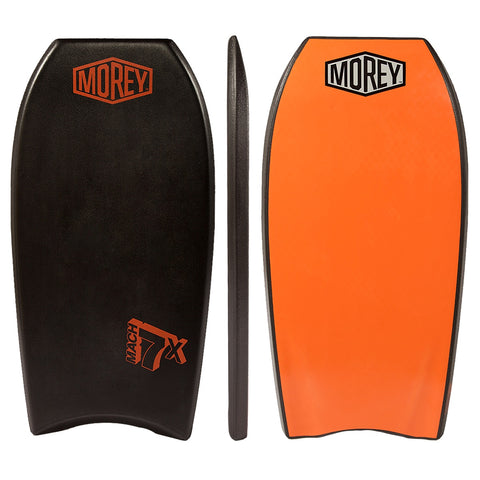
The Mach 7X is offered in a few color schemes: a blue deck with an orange slick and black accents, and a black deck with an orange slick and orange accents.
One area the Mach 7X has improvements over the original Mach 7 is in core type. The Mach 7X, much like the Mach 7X features a PP, or polypropylene core. Morey calls their proprietary core material X-Flex® Polypro, but other high-end boards feature similar PP cores. PP is known as the highest-end core type available, aside from some proprietary cores. PP cores are known to be solid performers in varying water temperatures and surf conditions. This core's durability and flex are boosted further with the 7X's X-Flex® Mesh system.
The deck in a Mach 7X is the same material as a base Mach 7 or a Mach 7SS: TC8 polyethylene. TC8 decks are very good in terms of durability.
One major difference between the Mach 7X and the Mach 7SS is the slick. While the higher-end Mach 7SS offers a Surlyn® slick, the best (and most expensive) slick type available, the Mach 7X offers an HDPE slick. HDPE slicks are still very solid performers, and are a bit more economical than Surlyn®.
Like the other Mach 7 models, the Mach 7X offers a Crescent Tail. Crescent Tails are good for fast turns and drop knee riders. They're also well-regarded as a great beginner tail type.
The Mach 7X, much like the base model Mach 7, offers a single Power Rod Stringer. This will give the core a bit more flex and durability, but not as much durability as the double Power Rod Stringers seen in the Mach 7SS.
The Mach 7X weighs in at 6 lbs. The Mach 7X is offered in 41.5" and 42.5" sizes, which should be a great fit for most riders. If you're unsure of your board size, you can check out our size calculator here.
Now that we know about a few of the most popular Mach 7 boards, let's check out the history of the Mach 7!
The Mach 7 has had a pretty long history, with various iterations and models over time.
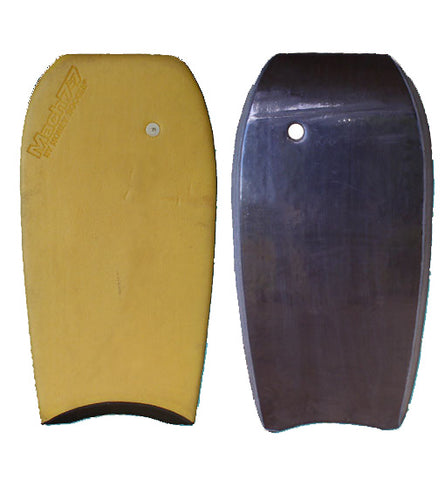
The first revision of the Mach 7-7 was in 1982. One of the first Mach 7 boards, the Mach 7-7's differentiator was its "ion speed" slick. Compared to the other boards available at the time, this slick type offered serious speed and was the pioneer in slick innovations. The board also had 70/30 rails. It featured the original yellow deck with a black slick, which was later changed to the orange slick we see in the Mach 7 today.
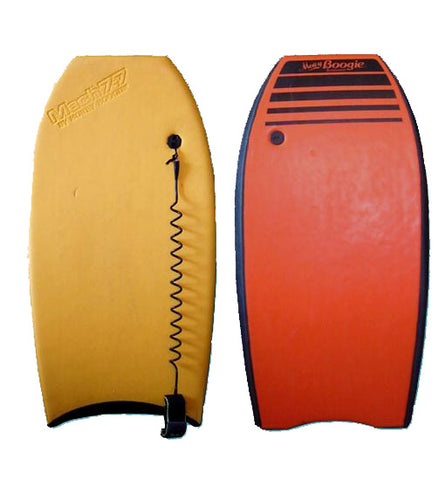
The second revision of the Mach 7-7 came in 1984, featuring Morey's Crescent Tail and 60/40 rails. You can still find 60/40 rails in the Cruiser today - they offered serious speed and maneuverability.
One of the reasons the Mach 7 exploded in popularity with this model was price. The main thing the Mach 7 was able to do was bring features from pro boards and bring them down to the masses.
The classic yellow/orange look came in this revision.
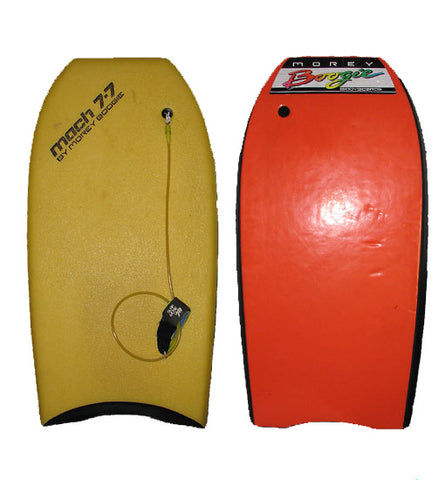
In 1989 a more enhanced orange bottom with a rainbow Morey logo. Oh, the classic Morey logo. I wish they had some models nowadays with it.
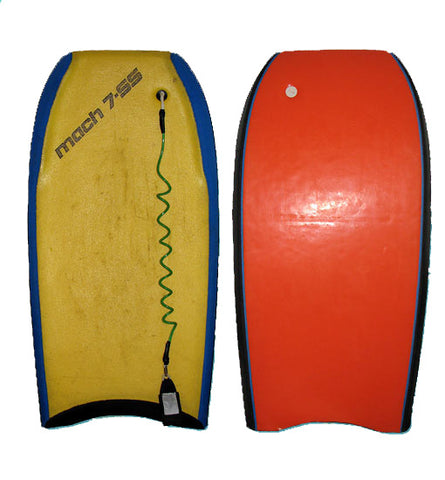
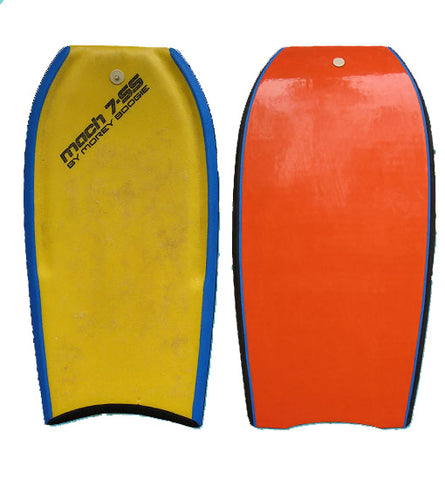
In 1991, we saw a revision to the Mach 7-SS, dropping the big rail grips in favor of a smoother rail system. No addition of a rainbow Morey logo was added, however, the deck added "BY MOREY BOOGIE" text to the bottom of the Mach 7-SS logo.
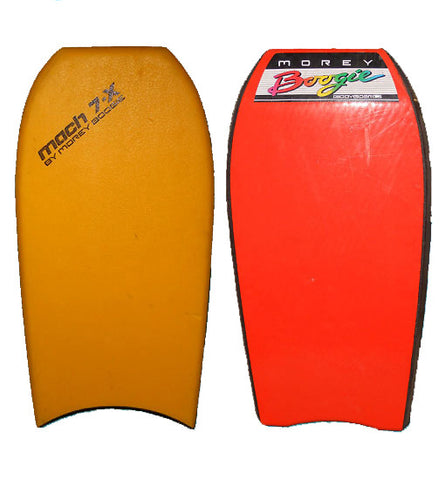
Additionally released in 1991 were models from pro bodyboarders Jay Reale and Mike Stewart, who offered their own twists on the board.
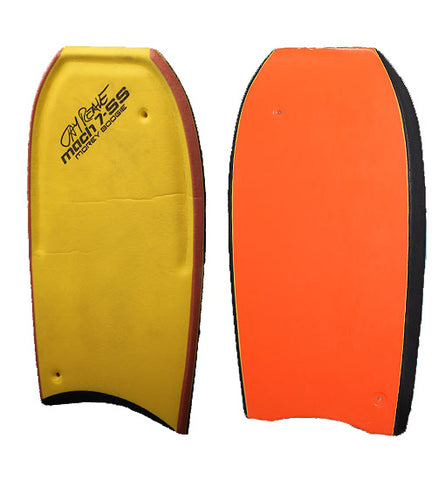
Reale's model offered a higher wide point, better for prone riding, and a smaller nose, for drop knee. Chines in this model were swapped to red.
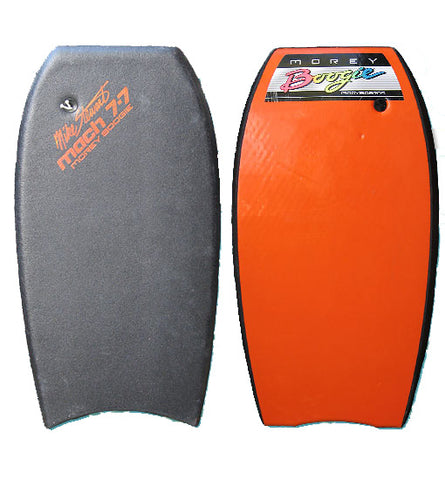
Stewart's model offered the X-Flex® core into the Mach 7-7 in addition to a black deck skin and black chines.
In 1994 came a Jay Reale Mach 7-SS and the Mach 7-X.
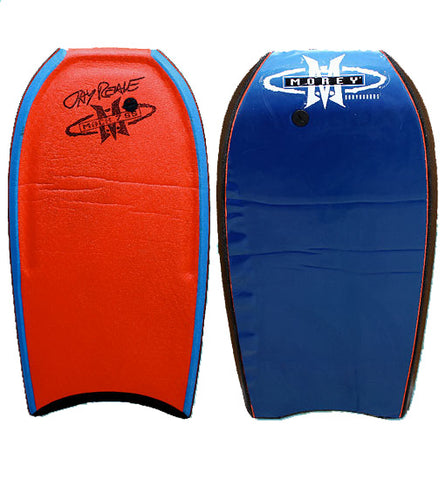
The 1994 Reale Mach 7-SS featured an X-Flex® core along with the earlier changes from the other Reale model. This model changed the board length to 41", and added bright blue chines, a red deck, and a dark blue slick with red accents. Included was a custom logo with signature on the deck, with a revised Morey logo on the slick.
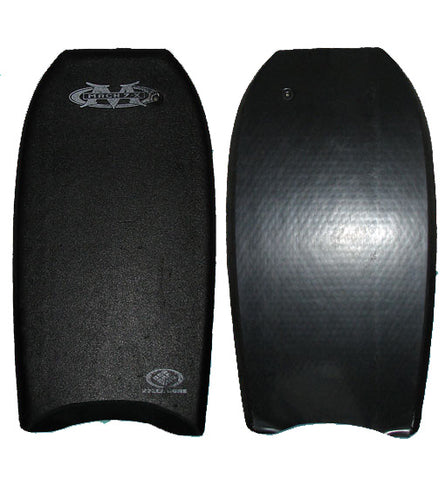
The Mach 7-X added an X-Flex® core officially to the Mach 7, and came in all black - black chines, black rails, black deck and black slick. It featured a custom Mach 7-X logo on the front.
The transitionary period in 1991 to 1994 changed the "Morey Boogie" name to "Morey Bodyboards".
The second generation of the Mach 7-X then added a dark green tail.
As you can see, the Mach 7 is a serious board with a serious history. Since 1982, the Morey Mach 7 has brought many innovations from pro level boards to everyday riders at an affordable price point.
If you're interested in the Mach 7, you can grab a Mach 7 here.
ⓘ Interested in the Mach 7? Check out the following links:
→ Check out the Mach 7 at Beachgoer
→ The History of Morey Bodyboards at VintageBodyboards
Special thanks to Rob at VintageBodyboards, who helped us with some historical info and images for this article. Vintage bodyboards in this post are credit of VintageBodyboards and VintageBodyboards image donors.